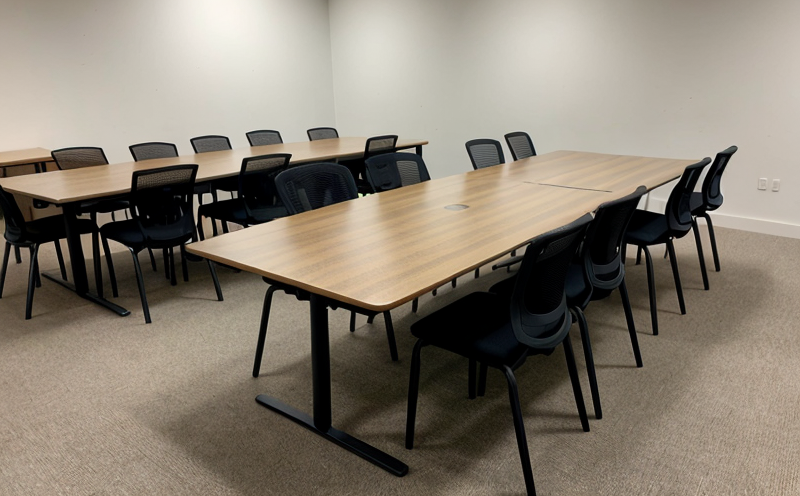UNE 11016 Wooden Furniture Surface Coating Resistance Testing
The UNE 11016 standard is specifically designed to evaluate the resistance of surface coatings on wooden furniture against various chemical agents. This test is crucial for manufacturers and quality managers who want to ensure their products meet stringent durability and safety standards in the market.
Wooden furniture, especially those intended for public spaces or environments with high traffic and exposure to chemicals like household cleaners or solvents, must withstand harsh conditions without compromising its structural integrity. The UNE 11016 test helps manufacturers identify potential weaknesses in their coatings early on, allowing them to make necessary adjustments before product release.
The testing process involves exposing coated wooden surfaces to a series of chemical agents under controlled laboratory conditions for specified durations. After this exposure period, the samples are thoroughly examined and evaluated based on predefined criteria set forth by UNE 11016. These criteria include assessing the extent of any visible damage or degradation observed post-exposure.
By conducting such tests, manufacturers can demonstrate compliance with relevant regulations while also enhancing consumer confidence regarding the longevity and safety of their products. This not only protects brand reputation but also fosters trust among consumers seeking high-quality furnishings for their homes or offices.
The UNE 11016 standard ensures that wooden furniture meets rigorous performance requirements, providing peace of mind to both producers and purchasers alike. It serves as an essential tool in maintaining quality standards across the industry by offering a standardized method for evaluating surface coating resistance against chemicals.
Understanding the importance of this test allows stakeholders within the sector to appreciate its significance in ensuring product durability and safety. Compliance with UNE 11016 is not just about meeting regulatory requirements but also about contributing positively towards sustainable practices that benefit all parties involved—from raw material suppliers through production processes right up until final consumer use.
For those involved in research & development (R&D) or quality assurance at furniture manufacturers, understanding how UNE 11016 works can provide valuable insights into optimizing coating formulations and improving overall product performance. By leveraging this knowledge effectively, companies can stay ahead of competitive trends while simultaneously addressing broader environmental concerns related to resource efficiency.
Additionally, procurement teams responsible for sourcing materials may find value in knowing about UNE 11016 because they too play a critical role in ensuring suppliers adhere to these stringent standards. Through informed decision-making based on knowledge gained through participation in such tests, procurement professionals can help drive innovation and cost-effective solutions within their organizations.
In summary, compliance with the UNE 11016 standard is vital for manufacturers aiming to produce robust wooden furniture that stands up against real-world challenges posed by environmental factors like chemicals commonly found in homes or offices. By implementing this testing process early on during development stages, companies can ensure they meet all necessary requirements while also enhancing their reputation for producing reliable products.
Why It Matters
The durability and safety of wooden furniture are paramount considerations for consumers across various sectors including residential homes, commercial buildings, schools, hospitals, and public spaces. In environments where frequent handling or exposure to chemicals is expected, ensuring that the surface coatings on these pieces remain intact becomes even more critical.
- Residential Homes: Furniture in homes should be durable enough to withstand daily use without showing signs of wear and tear prematurely.
- Commercial Buildings: Public areas such as lobbies or waiting rooms require sturdy furniture capable of withstanding higher levels of foot traffic compared to private residences.
- Schools & Universities: Educational institutions often have large numbers of students who can cause accidental damage if not careful. Ensuring that the furniture used in classrooms remains intact throughout its lifecycle is important for maintaining a conducive learning environment.
- Hospitals: Medical facilities need reliable medical equipment and furnishings that do not pose any risks to patients or staff through potential failures caused by substandard materials.
- Public Spaces: Parks, libraries, and other community centers rely on sturdy furniture pieces that can stand up against harsh weather conditions as well as regular usage.
Incorporating UNE 11016 into the manufacturing process helps guarantee that the wooden surfaces remain protected from harmful chemicals, thereby extending the lifespan of each piece. This ultimately contributes to cost savings for consumers who are less likely to need frequent replacements due to premature failure.
Applied Standards
The UNE 11016 standard specifies detailed procedures and criteria for evaluating the resistance of surface coatings on wooden furniture against chemical agents. It provides a robust framework that ensures consistent results across different laboratories performing these tests, promoting reliability in quality assessments.
The primary objective of UNE 11016 is to assess how well the coating adheres to the underlying wood structure when exposed to various chemicals commonly encountered in everyday use or storage conditions. This includes solvents like acetone and methanol, as well as household cleaners containing alkalis or acids.
For each chemical agent used during testing, there are specified concentrations and durations of exposure intended to simulate realistic scenarios faced by furniture in specific environments. After the prescribed contact time has elapsed, the samples undergo visual inspection for any signs of damage such as discoloration, cracking, peeling, or loss of adhesion.
UNE 11016 also includes provisions for quantifying the extent of any observed changes using appropriate measurement techniques like cross-sectional analysis or microscopic examination. This allows for objective evaluation and comparison between different samples or batches produced by various manufacturers.
The standard further emphasizes the importance of proper sample preparation prior to testing, including cleaning procedures, sanding methods if necessary, and ensuring consistent thicknesses across all specimens being tested. By adhering strictly to these guidelines, researchers and technicians can ensure that their findings accurately reflect the actual performance characteristics of the coated wooden surfaces.
Compliance with UNE 11016 demonstrates a commitment to producing high-quality products that meet international standards recognized by regulatory bodies worldwide. This not only enhances brand reputation but also opens up opportunities for exporting goods internationally where similar requirements might apply.





